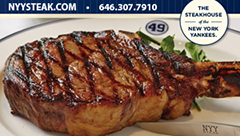GRÜNHAUS
A TASTE OF BAVARIA ON THE LES
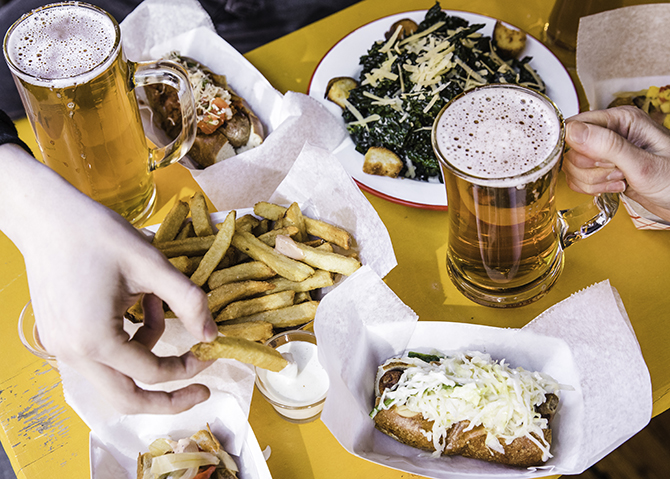
By Darren Paltrowitz
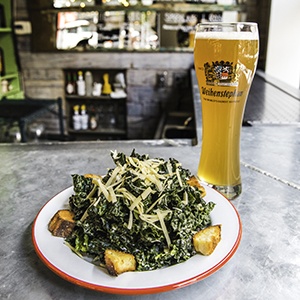 Black Kale Salad
Black Kale SaladOpened last month, Grünhaus is arguably the only traditional beer hall you will find on the Lower East Side. Much like its sister bar, Brooklyn’s Spritzenhaus, Grünhaus is spacious and full of both greenery, and communal tables.
When the weather is cooperative, Grünhaus’s garage-style windows open up, transitioning it into a breezy beer garden. Beyond the inviting atmosphere, Grünhaus also delights with its food and beverage offerings, with 30 rotating beers on tap, as well as ten house sausages, ten dipping sauces, Belgian fries, and Sigmund’s soft pretzels.
Recently, I had the pleasure of speaking with Grünhaus co-owner Emily Shamlian about her new establishment—which has already received rave reviews from the New York Times and UrbanDaddy alike.
How would you describe Grünhaus?
Grünhaus is a fresh take on a traditional German beer garden. The airy atmosphere and lush greenery make it feel like you’re sipping your beer in an indoor park under the ambient glow of garden lights. Ultimately, Grünhaus is about hanging out and enjoying the company of family and friends over a brew—or whatever your beverage of choice may be—a bratwurst and perhaps a game of Jenga.
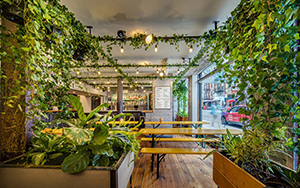
How does Grünhaus compare to Spritzenhaus?
Both places share a passion for beer, an open kitchen concept, huge windows, and friendly, laid-back vibe. But each has its own personality influenced by its location. Inspired by turn of century European train stations, Spritzenhaus is three times the size and is housed in a former warehouse in Williamsburg-Greenpoint. Grünhaus takes up the ground floor of a LES building (circa: 1910), its décor is an ode to an outdoor beer garden. It’s a bit more intimate.
What is the hardest part of having an open space venue?
The fact that it is an open space venue has not been a challenge at Grünhaus; the open kitchen makes cooking part of the show, which adds to the atmosphere. The tricky part has been caring for all of the plants!
How long did it take to develop Grünhaus? Was it years in the making?
We looked for a venue to open a sister to Spritzenhaus for a few years. The build-out was quick because the design vision was evident. We’ve worked with Asfour Guzy Architects and Hecho on other projects in the past and were thrilled to have them join creative forces again for Grünhaus. They did a stellar job.
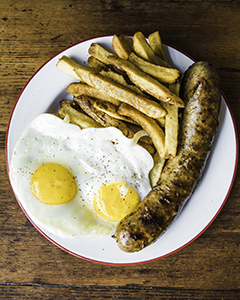 Brunch Brat
Brunch BratTell us some of your favorite items on the menu?
The Belgian fries are amazing—best in New York City in our humble opinion—especially when paired with the dipping sauces. My favorites are the house sauces: the chipotle aioli and the blue cheese bacon mayo. But you really can’t go wrong with any of the choices, and I recommend you mix it up. The warm, soft pretzels are also a must for some dipping action.
Perhaps a bit out of the box for a beer hall is Black Kale Salad as the perfect lemony, crunchy precursor to a bratwurst. Hard to pick a favorite sausage, but my go-to is the Biali Kielbasa topped with Jalapeno-Jicama Slaw or the Argentinian with Sauerkraut and mustard. I wash it down with a Weihenstephan Vitus.
When not busy with Grünhaus, how do you like to relax?
Hanging out with our kids—who happen to love bratwurst and soft pretzels—and they keep us on our toes. In fact, we are headed to Munich next week to visit breweries. And, yes, we will definitely visit a beer hall or two while we are at it.
Finally, Emily, any last words?
One of the things that makes beer halls so appealing and convivial is the fact that they are a gathering place for all ages. At Grünhaus this tradition continues. It’s all part of the fun!
For more information on Grünhaus, visit grunhausnyc.com.
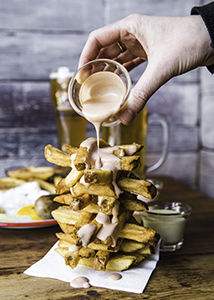 Belgian Fries
Belgian FriesA GERMAN TRADITION
Beer gardens have long been a tradition in Bavaria. As soon as temperatures rise, you’ll find Germans flocking to the nearest beer garden. It’s the only place to be and enjoy a lager (or two) under the shade of a big chestnut tree.
In earlier times, when refrigeration did not exist, brewers still needed to keep their beer cool during warm months. So what did they do? Inventive as people are, they dug stone cellars into the underground to store the beer barrels. On top of these cellars they planted chestnut trees, to give shadow and keep the place fresh and cool. This is why you see so many chestnut trees in Bavaria.
Of course, storing cool beer in this fashion presented the idea to the region’s brewers. Why not sell beer right on the spot? Thus, the tradition of beer garden was born.





